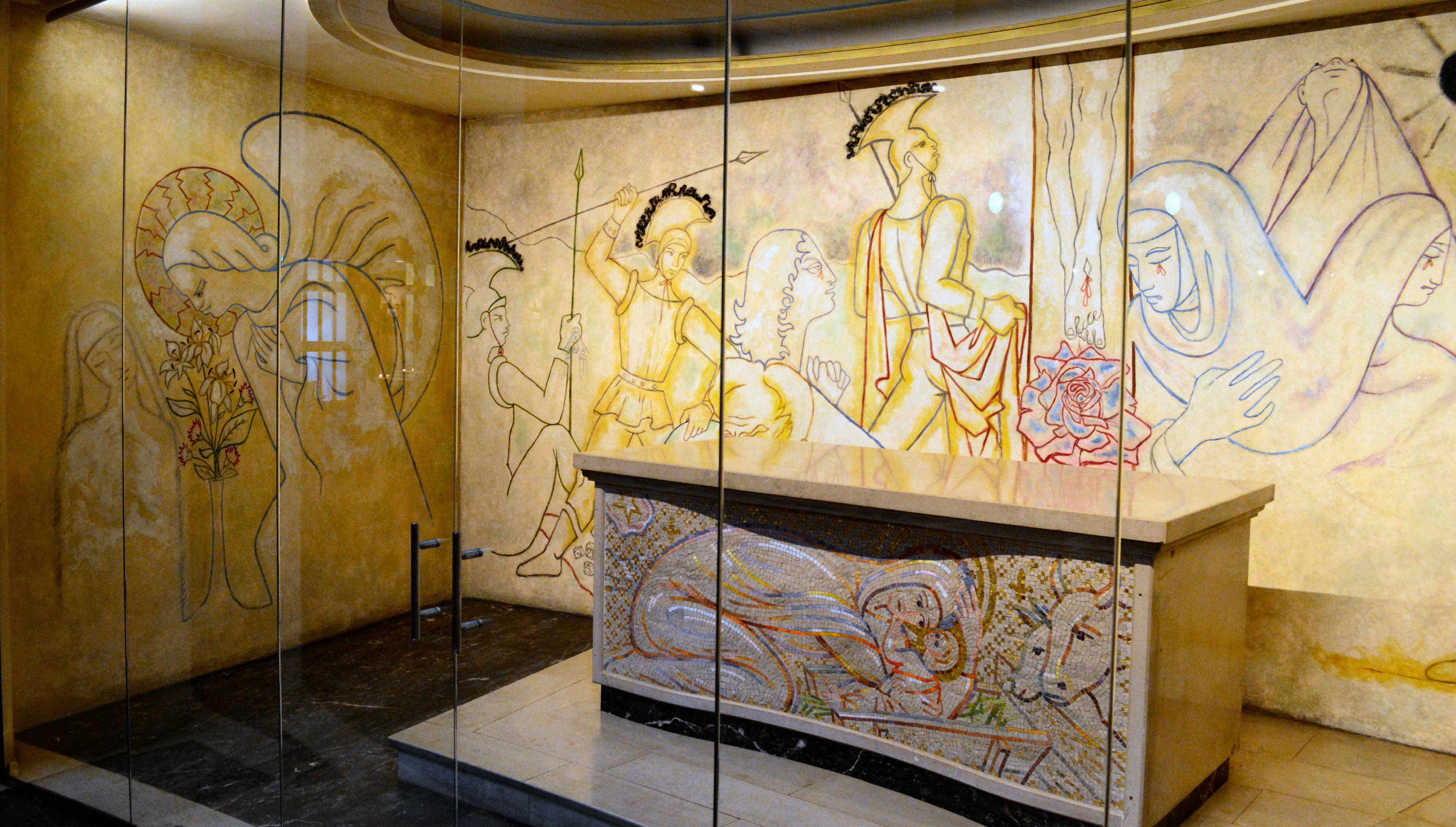St Michael Cornhill
City of London, Greater London
The church lies over the remains of the Basilica, the northern most part of the great Roman Forum built in the first century AD.

Corfiato’s church is important as an advanced design showing the influence of the Liturgical Movement, and as a showcase of Art Sacré, notably the murals in the Lady Chapel by Jean Cocteau.
Soho, Greater London
The church stands on the site of Leicester House, built in the 1630s for the first Earl of Leicester. It lies to the north of Leicester Square, laid out in 1670 by the second Earl, and originally called Leicester Fields. Leicester House was demolished in about 1790 and Leicester Place laid out across the site. Here was constructed in 1793-94 from designs by Robert Mitchell a large rotunda, used as a diorama. In 1865 this building and two adjoining houses were acquired by Père Charles Faure, of the Marist Fathers, for use as a church for the French Catholics population of London. The diorama was converted to a church in 1865-68 by the French architect Louis Auguste Boileau, and was notable for its iron construction (Boileau later worked with Gustave Eiffel). The church was opened on 11 June 1868. The church was of Greek cross plan, formed within the circular shell of Mitchell’s diorama. Its chief internal furnishing was the statue of Our Lady on the altar of Notre Dame des Victoires, a copy of a statue in the Paris church of that name.
In 1940 Boileau’s church suffered from bomb damage, but was repaired in the following year by architects Hall, Easton & Robertson. The statue of Our Lady of Victories was destroyed, but the head was salvaged and parachuted into France in 1942, where it was restored and incorporated in a new figure by the sculptor Henri Vallette (1891-1962), returning to London in 1945.
In the early 1950s, a decision was taken to rebuild the church. With the encouragement of the Cultural Attaché René Varin, this was to become a showcase of Art Sacré, or modern French sacred Catholic art of a generally left-leaning and progressive sort which sought to legitimise artistic Modernism, particularly after its denunciation by Pope Pius XI in 1932. The foundation stone (brought from Chartres Cathedral) was laid on 31 May 1953, and the church was opened on 6 October 1955. Like its predecessor, the new church was circular on plan with twelve Doric columns supporting a domed roof, and with an ambulatory and galleries around the central space.
Artists employed in the fitting out of the new church included the Benedictine monk Dom Robert de Chaumac (1907-1977), who designed the large tapestry behind the altar on the theme of Paradise on earth, woven in Aubusson (1954); Professor Georges-Laurent Saupique (1889-1961) and his students at the École des Beaux-Arts, Paris, responsible for sculpture and other carved stonework on the exterior (1953); the Russian-born artist Boris Anrep (1863-1969), an altar front with a mosaic of the Nativity, covered for many years and only recently revealed (dating from 1954, i.e. before his major work at Westminster Cathedral); and, most famous of all, Jean Cocteau (1889-1963), a friend of Dom Robert’s, who painted the murals in the Lady Chapel between 3 and 11 November 1959. These are Cocteau’s only murals in the United Kingdom. They are divided into three panels, depicting the Annunciation, the Crucifixion and the Assumption. The murals are simplified line drawings, with sparing use of colour. Cocteau included a portrait of himself in the Crucifixion scene.
City of London, Greater London
The church lies over the remains of the Basilica, the northern most part of the great Roman Forum built in the first century AD.
City of London, Greater London
The Dutch Church is a reformed church on the site of the 13th century Augustinian friary, the original building granted to Protestant refugees for their church services in 1550 was destroyed during the London Blitz.
Marshfield, Gwent
Mae Eglwys St Mair, Maerun, yn eglwys brydferth sy’n dyddio nôl i’r ddeuddegfed ganrif. Yn nythu’n glud yn y llain las rhwng Caerdydd a Chasnewydd, mae bellach yn adnabyddus am fod yn lleoliad ar gyfer un o episodau Dr Who!